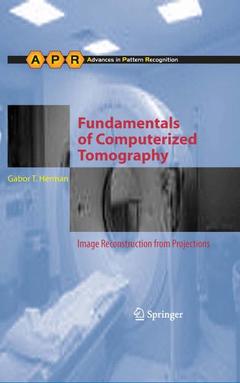Description
Fundamentals of Computerized Tomography (2nd Ed., 2nd ed. 2010)
Image Reconstruction from Projections
Advances in Computer Vision and Pattern Recognition Series
Author: Herman Gabor T.
Language: English
Subjects for Fundamentals of Computerized Tomography:
Publication date: 03-2012
300 p. · 15.5x23.5 cm · Paperback
Publication date: 09-2009
300 p. · 15.5x23.5 cm · Hardback
Description
/li>Contents
/li>Comment
/li>
This revised and updated text presents the computational and mathematical procedures underlying data collection, image reconstruction, and image display in computerized tomography. New topics: the fast calculation of a ray sum for a digitized picture, the task-oriented comparison of reconstruction algorithm performance, blob basis functions and the linogram method for image reconstruction. Features: Describes how projection data are obtained and the resulting reconstructions are used; Presents a comparative evaluation of reconstruction methods; Investigates reconstruction algorithms; Explores basis functions, functions to be optimized, norms, generalized inverses, least squares solutions, maximum entropy solutions, and most likely estimates; Discusses SNARK09, a large programming system for image reconstruction; Concludes each chapter with helpful Notes and References sections. An excellent guide for practitioners, it can also serve as a textbook for an introductory graduate course.
Describes how projection data are obtained and used in science and medicine, focusing on x-ray data but also covering other fields such as electron microscopy, nuclear medicine, ultrasound, materials science and nondestructive testing
Presents a comparative evaluation of reconstruction methods, their accuracy under ideal and realistic circumstances, computational costs, task-oriented performance, and applicability
Provides a useful general syllabus for introductory courses
Investigates reconstruction algorithms, including filtered backprojection, Fourier and linogram reconstruction methods, algebraic reconstruction techniques, and quadratic optimization




